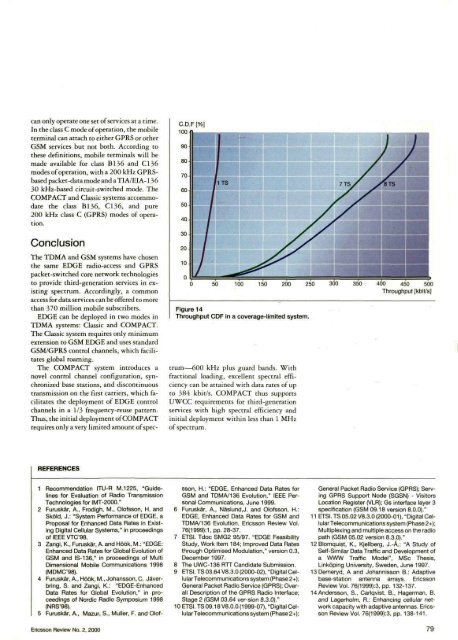ericssonhistory.com
ericssonhistory.com
ericssonhistory.com
- No tags were found...
Create successful ePaper yourself
Turn your PDF publications into a flip-book with our unique Google optimized e-Paper software.
can only operate one set of services at a time.In the class C mode of operation, the mobileterminal can attach to either GPRS or otherGSM services but not both. According tothese definitions, mobile terminals will bemade available for class B136 and CI36modes of operation, with a 200 kHz GPRSbasedpacket-data mode and a TIA/EIA-13630 kHz-based circuit-switched mode. TheCOMPACT and Classic systems ac<strong>com</strong>modatethe class B136, CI36, and pure200 kHz class C (GPRS) modes of operation.ConclusionThe TDMA and GSM systems have chosenthe same EDGE radio-access and GPRSpacket-switched core network technologiesto provide third-generation services in existingspectrum. Accordingly, a <strong>com</strong>monaccess for data services can be offered to morethan 370 million mobile subscribers.EDGE can be deployed in two modes inTDMA systems: Classic and COMPACT.The Classic system requires only minimumextension to GSM EDGE and uses standardGSM/GPRS control channels, which facilitatesglobal roaming.The COMPACT system introduces anovel control channel configuration, synchronizedbase stations, and discontinuoustransmission on the first carriers, which facilitatesthe deployment of EDGE controlchannels in a 1/3 frequency-reuse pattern.Thus, the initial deployment of COMPACTrequires only a very limited amount of spec-Figure 14Throughput CDF in a coverage-limited system.trum—600 kHz plus guard bands. Withfractional loading, excellent spectral efficiencycan be attained with data rates of upto 384 kbit/s. COMPACT thus supportsUWCC requirements for third-generationservices with high spectral efficiency andinitial deployment within less than 1 MHzof spectrum.REFERENCES1 Re<strong>com</strong>mendation ITU-R M.1225, "Guidelinesfor Evaluation of Radio TransmissionTechnologies for IMT-2000."2 Furuskar, A., Frodigh, M., Olofsson, H. andSkold, J.: "System Performance of EDGE, aProposal for Enhanced Data Rates in ExistingDigital Cellular Systems," in proceedingsof IEEE VTC'98.3 Zangi, K., Furuskar, A. and Hook, M.: "EDGE:Enhanced Data Rates for Global Evolution ofGSM and IS-136," in proceedings of MultiDimensional Mobile Communications 1998(MDMC'98).4 Furuskar, A., Hook, M., Johansson, C. Javerbring,S. and Zangi, K.: "EDGE-EnhancedData Rates for Global Evolution," in proceedingsof Nordic Radio Symposium 1998(NRS'98).5 Furuskar, A., Mazur, S., Muller, F. and Olofsson,H.: "EDGE, Enhanced Data Rates forGSM and TDMA/136 Evolution," IEEE PersonalCommunications, June 1999.6 Furuskar, A., Naslund.J. and Olofsson, H.:EDGE, Enhanced Data Rates for GSM andTDMA/136 Evolution. Ericsson Review Vol.76(1999):1, pp. 28-37.7 ETSI. Tdoc SMG2 95/97. "EDGE FeasibilityStudy, Work Item 184; Improved Data Ratesthrough Optimised Modulation," version 0.3,December 1997.8 The UWC-136 RTT Candidate Submission.9 ETSI. TS 03.64V8.3.0 (2000-02), "Digital CellularTele<strong>com</strong>munications system (Phase 2+);General Packet Radio Service (GPRS); OverallDescription of the GPRS Radio Interface;Stage 2 (GSM 03.64 ver-sion 8.3.0)."10 ETSI. TS 09.18 V8.0.0 (1999-07), "Digital CellularTele<strong>com</strong>munications system (Phase 2+);General Packet Radio Service (GPRS); ServingGPRS Support Node (SGSN) - VisitorsLocation Register (VLR); Gs interface layer 3specification (GSM 09.18 version 8.0.0)."11 ETSI. TS 05.02 V8.3.0 (2000-01), "Digital CellularTele<strong>com</strong>munications system (Phase 2+);Multiplexing and multiple access on the radiopath (GSM 05.02 version 8.3.0)."12Blomquist, K., Kjellberg, J.-A.: "A Study ofSelf-Similar Data Traffic and Development ofa WWW Traffic Model", MSc Thesis,Linkbping University, Sweden, June 1997.13Derneryd, A and Johannisson B.: Adaptivebase-station antenna arrays. EricssonReview Vol. 76(1999):3, pp. 132-137.14Andersson, S., Carlqvist, B., Hagerman, B.and Lagerholrn, R.: Enhancing cellular networkcapacity with adaptive antennas. EricssonReview Vol. 76(1999):3, pp. 138-141.Ericsson Review No. 2, 2000 79















